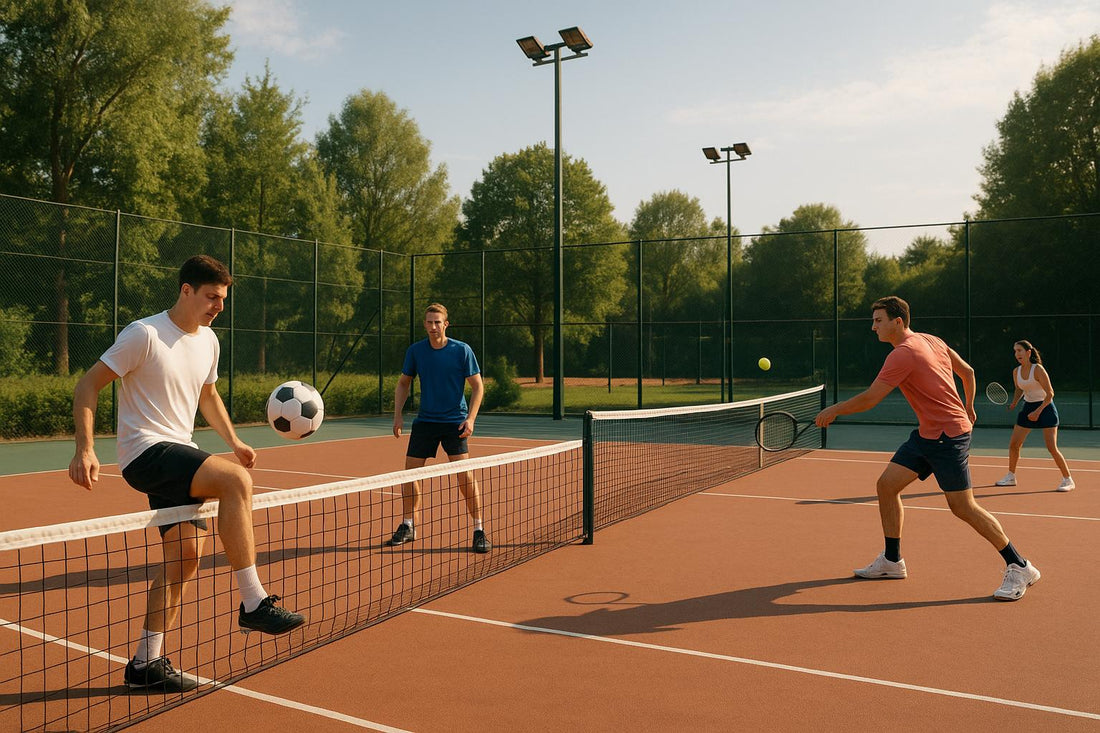
Soccer Tennis vs Traditional Tennis: Key Differences
Soccer tennis and tennis may both involve a net, but they’re worlds apart in how they’re played, the skills required, and the gear needed. Soccer tennis uses a soccer ball and body parts like feet and head, while tennis relies on rackets and a tennis ball. The former thrives on flexibility in rules and location, while the latter sticks to formal courts and standardized gameplay. Here’s what you need to know:
- Soccer Tennis: Played with a soccer ball using feet, chest, and head. Formats include singles, doubles, or triples. Portable and low-cost, it can be played anywhere.
- Tennis: Played with rackets and tennis balls. Requires a dedicated court. Focuses on precision, speed, and endurance.
Quick Comparison
| Feature | Soccer Tennis | Tennis |
|---|---|---|
| Ball | Soccer ball | Tennis ball |
| Equipment | Net or barrier, athletic shoes | Racket, tennis shoes, regulation net |
| Court | Any flat surface | Dedicated tennis court |
| Team Formats | Singles, doubles, triples | Singles, doubles |
| Touches Allowed | 2 (singles), 3 (doubles/triples) | 1 touch |
| Scoring | 11 points, 2-point lead to win | Love-15-30-40-game, sets |
Soccer tennis is casual and accessible, great for quick games anywhere. Tennis offers a structured, competitive environment with a focus on skill mastery. Both sports are fun, but they cater to different preferences and play styles.
How to Play Soccer Tennis and Be The BOSS At It
Rules and Gameplay Differences
The rules that define soccer tennis and traditional tennis set the stage for two very different sporting experiences. While both involve sending a ball over a net, the way players score, interact, and navigate the game couldn’t be more distinct. Let’s break down the unique rulebooks that shape each sport.
Soccer Tennis Rules
Soccer tennis offers a flexible structure, making it suitable for players of varying skill levels and group sizes. The primary objective is simple: volley a soccer ball over the net without using your hands or arms. This limitation pushes players to master ball control using their feet, chest, head, and legs.
Team formats in soccer tennis bring more variety compared to traditional tennis. You can play singles, doubles, or even triples. Each format shifts the game dynamics - singles demand more individual skill and endurance, while doubles and triples focus on teamwork and strategic positioning.
The touch system adds another layer of complexity. In singles, players get two touches per rally, while doubles and triples allow three touches. This rule encourages creative play and coordination, especially in team settings.
Bounce rules also vary depending on the competition. Typically, men’s doubles and triples allow one bounce, while women’s and junior doubles often permit two bounces. This adaptability makes the sport welcoming to newcomers while keeping it challenging for seasoned players.
Scoring in soccer tennis is straightforward. Matches are played in a best-of-three format, with each set going to 11 points, requiring a two-point lead to win. This system keeps games short, intense, and action-packed.
Traditional Tennis Rules
Traditional tennis, on the other hand, follows a standardized rule set. Players use rackets to hit a tennis ball over the net, aiming to land shots within the opponent’s court while preventing a successful return.
Player formats are more limited in traditional tennis, with only singles and doubles options. While singles focus on individual skill, doubles rely on teamwork, but there’s no expansion beyond two-player teams.
The one-touch rule defines the pace of traditional tennis. Players must return the ball after a single bounce, leaving no room for extended setups like in soccer tennis. This demands quick reflexes and precise movement.
Traditional tennis employs a layered scoring system. Points progress through love (zero), 15, 30, 40, and game, with specific rules for deuce and advantage situations. Sets are made up of multiple games, and matches can consist of best-of-three or best-of-five sets.
Service rules add yet another dimension. Players alternate serving entire games, and specific guidelines govern foot faults, double faults, and let serves. For instance, if a serve hits the net but lands in the correct service box, it’s replayed instead of being counted as a fault.
Rules Comparison Table
| Feature | Soccer Tennis | Traditional Tennis |
|---|---|---|
| Objective | Volley soccer ball using body parts except hands/arms | Hit tennis ball with racket over net |
| Team Formats | Singles, doubles, or triples | Singles or doubles only |
| Touches Allowed | 2 (singles), 3 (doubles/triples) | 1 touch only |
| Bounces Permitted | 1 (men’s), 2 (women’s/juniors) | 1 bounce maximum |
| Scoring System | 11 points, 2-point differential | Love-15-30-40-game, then sets |
| Equipment Contact | Feet, chest, head, legs only | Racket only |
| Match Format | Best-of-three sets to 11 points | Best-of-three or best-of-five sets |
One of the most noticeable differences is in rule flexibility. Soccer tennis encourages players to tweak rules based on skill level, available space, or recreational goals. Adjustments can include changes to bounce rules, team sizes, or even scoring systems, creating a more adaptable experience. In contrast, traditional tennis adheres strictly to its established rules, leaving little room for variation during formal play.
This flexibility extends to net play as well. In soccer tennis, if the ball hits the net and bounces back to the team that hit it, the play ends for that team. Traditional tennis, however, allows players to continue as long as the ball lands within the court boundaries.
Next, we’ll explore how equipment and playing surfaces further set these sports apart.
Equipment and Playing Surface
The equipment needs for soccer tennis and traditional tennis reveal clear differences in complexity, cost, and portability. While traditional tennis requires specific gear and a dedicated court, soccer tennis embraces a simpler, more portable approach. These distinctions set the stage for a closer look at playing surfaces and associated costs.
Soccer Tennis Equipment
Soccer tennis keeps things straightforward. All you need is a soccer ball, a net or barrier, boundary markers, and athletic shoes. For those looking to upgrade their game, Kickit offers a specialized Soccer Tennis Ball for $24.99. It’s designed for durability and works well on all surfaces. Complete portable sets are also available: the Kickit Soccer Tennis set costs $79.99, while the Kickit Soccer Tennis Pro (Doubles) and Kickit Inferno Soccer Tennis sets are priced at $129.99. These include a ball, net, pump, and boundary markers.
The net system is flexible - you can use a standard tennis net, a portable soccer tennis net, or even makeshift barriers. Boundary markers, like cones, allow you to adjust the court size to fit your space and skill level. Any good pair of athletic shoes will do the trick.
Kickit sets are designed for convenience, assembling in under a minute and packing into compact carry bags. Whether you’re at the beach, a park, or even your driveway, setting up a game is quick and easy.
Traditional Tennis Equipment
On the other hand, traditional tennis requires a more significant investment in both equipment and infrastructure. Players need tennis rackets and regulation tennis balls that meet strict standards for bounce and durability. The net - a regulation tennis net standing 3 feet high at the center - must be installed on a dedicated court. Proper tennis shoes are also essential, offering the support and grip needed for the sport’s quick movements.
Unlike soccer tennis, traditional tennis relies on permanent court installations. These courts - whether hard, clay, or grass - directly impact gameplay by influencing ball bounce and player strategy. However, they also demand regular maintenance and considerable infrastructure.
Equipment Comparison Table
Here’s a quick comparison to highlight the key differences:
| Equipment Category | Soccer Tennis | Traditional Tennis |
|---|---|---|
| Ball | Soccer ball ($24.99) | Tennis balls (multiple required) |
| Net | Portable or improvised barrier | Regulation tennis net (3 ft height) |
| Racket/Paddle | Not required | Tennis racket (essential) |
| Court Surface | Any flat surface | Dedicated tennis court |
| Footwear | Standard athletic shoes | Specialized tennis shoes |
| Setup Time | Under 60 seconds | Permanent installation |
| Portability | High (sets $79.99–$129.99) | Low (court-dependent) |
| Surface Flexibility | Grass, sand, concrete, turf | Hard court, clay, grass |
Playing Surface Differences
The playing surfaces for these sports couldn’t be more different. Soccer tennis can be played on nearly any flat area - beach sand, gym floors, backyard grass, you name it. As Pioneer Athletics puts it:
"The All-Surface Soccer Tennis is 2'8″H x 10'W and encourages players to enhance basic skills such as trapping, heading, and deftness of touch while having fun".
In contrast, traditional tennis is tied to dedicated courts. Each surface type - hard, clay, or grass - affects the ball’s behavior. Hard courts offer consistent bounce, clay courts slow the ball and produce a higher bounce, while grass courts provide faster play but require significant upkeep.
Cost and Accessibility
Cost differences are just as striking. A basic Kickit soccer tennis set starts at under $80, making it an affordable option. Meanwhile, traditional tennis involves expenses like court rentals, racket replacements, and equipment upkeep. Soccer tennis sets are also portable, fitting into carry bags for games wherever you find a flat surface. Traditional tennis, however, requires fixed court locations and more storage for gear.
These differences in equipment and playing surfaces not only shape how the games are played but also influence their accessibility and affordability, offering distinct opportunities for skill development in each sport.
sbb-itb-8dc5da3
Playing Techniques and Skills Required
The techniques and skills needed for soccer tennis and traditional tennis are quite distinct. Each sport demands its own set of abilities - from controlling the ball using different parts of the body to mastering unique movement patterns. This explains why excelling in one can feel entirely different from tackling the other.
Soccer Tennis Techniques
Soccer tennis revolves around controlling the ball with the feet, chest, and head. Since players can’t use their hands or arms, techniques like heading and chesting become essential. Key skills include kicking, heading, trapping, and juggling - all borrowed from soccer.
In this game, ball control is everything. Players often practice juggling and dribbling to maintain possession and set up plays. Serving with finesse or executing high kicks requires precise foot placement and perfect timing. Doubles play adds another layer of complexity, as partners must stay in sync, communicating and anticipating each other’s moves. Mixing up shots - whether it’s a topspin kick, a lob, or a drop shot - keeps opponents guessing and highlights the sport’s dynamic nature.
Traditional Tennis Techniques
In contrast, traditional tennis is all about mastering racquet skills. Players need to perfect strokes like serves, forehands, backhands, volleys, and footwork. Developing the proper grip, swing, and positioning takes years of consistent practice.
Quick reactions and sharp hand-eye coordination are crucial in tennis, especially when dealing with fast serves or returning tricky shots. According to an ESPN analysis, tennis ranks third among 60 sports for hand-eye coordination, with a score of 8.38 out of 10 - just behind baseball/softball (9.25) and table tennis (8.88). Serving in tennis is a biomechanical challenge that requires syncing the toss, racquet swing, and body rotation. On top of that, quick and precise footwork ensures players can position themselves effectively for every shot. The game’s fast pace - with points lasting around 8 seconds and work-to-rest ratios ranging from 1:2 to 1:5 - demands a mix of explosive power and stamina.
Skill Development Comparison
When it comes to skill development, each sport shapes athletes differently. Soccer tennis emphasizes agility, balance, and foot-eye coordination. Meanwhile, traditional tennis builds precise hand-eye coordination, upper body strength, and endurance .
Training methods reflect these differences. Soccer tennis players focus on agility drills, like ladder exercises or cone work, to sharpen speed and ball control. On the other hand, traditional tennis players dedicate time to refining racquet techniques, perfecting their serve mechanics, and improving shot timing.
Both sports offer distinct ways to develop athletic skills. Soccer tennis draws heavily from soccer-based techniques, while traditional tennis hones the precision and strategy of racquet sports. Together, they highlight how different training approaches can shape an athlete’s abilities in unique ways.
Physical and Recreational Benefits
Soccer tennis and traditional tennis both offer health perks, but they focus on different areas of fitness and provide unique recreational experiences. Knowing these differences can help you decide which sport aligns better with your fitness goals and lifestyle.
Physical Benefits
Traditional tennis delivers a full-body workout, improving cardiovascular endurance, muscle strength, flexibility, and coordination. Research shows that tennis players live an average of 9.7 years longer than non-exercisers. Plus, playing just three hours a week can reduce the risk of death from any cause by 50% and lower cardiovascular-related mortality by 56%.
The sport alternates between short bursts of intense activity and brief recovery periods, combining aerobic and anaerobic exercise. This mix enhances explosive power and stamina while being gentler on the joints compared to high-impact sports . The upper body also benefits from the repetitive motions of racquet swings and serves, promoting balanced muscle development.
On the other hand, soccer tennis focuses on continuous aerobic activity, building lower body strength and agility.
"Regardless of how you choose to GET OUT & PLAY, when it comes to cardiovascular fitness, basketball, soccer, and tennis each offer unique aerobic benefits." - Sport Court Texas
With Kickit products, soccer tennis is easy to enjoy for all ages and skill levels. Its portable design makes it possible to play on grass, driveways, or even sand, making regular exercise more convenient and accessible.
Recreational and Social Aspects
Beyond fitness, these sports provide different recreational and social opportunities. Traditional tennis is often played in structured settings like tennis clubs, which foster strong social connections. A USTA National study found that tennis players report significantly higher levels of social support compared to non-players.
One player shared their perspective:
"I enjoy competitive tennis A LOT, but I think if that was ALL I played I'd get burned out. I enjoy drills and clinics with my buddies, and just going out for a good hit with someone to work on cross-court forehands, or whatever. Maybe I'm wrong, but I gotta think that even the pro's find ways to have fun on the court, and not just be serious all the time." - Geezer Guy, Hall of Fame
In contrast, soccer tennis offers a more casual, flexible experience. It can be played almost anywhere by simply marking a field. This eliminates barriers like booking court time or traveling to specific facilities. The rules are also easily adaptable for different groups and skill levels, making it great for mixed-age gatherings and players of varying abilities.
Kickit's game sets make soccer tennis even more accessible, providing everything you need - nets, boundaries, balls, and pumps - in one portable package. The ability to play on any surface adds endless possibilities for where and how you can enjoy the game.
Both sports bring people together in their own ways: traditional tennis fosters structured social interaction and competitive growth, while soccer tennis offers spontaneous, inclusive fun that suits any group or setting.
Conclusion
Soccer tennis and traditional tennis each bring their own unique flavor to the table, catering to different preferences and play styles. Understanding these differences can help players see how each game offers its own kind of enjoyment and benefits.
Soccer tennis stands out for its ease and accessibility. With Kickit's all-in-one game sets - including nets, boundaries, balls, and pumps - you can set up a match in under a minute on virtually any surface. No need for court reservations, pricey memberships, or mastering tricky racket techniques. It’s a game that strips away barriers, blending the strategy of tennis with the universal love of soccer, making it perfect for spontaneous fun with friends or family.
If you're looking for a simple yet engaging way to stay active and connect with others, soccer tennis could be just the thing. Who knows? It might even become your go-to way to break a sweat and have a good time.
FAQs
What are the main physical benefits of playing soccer tennis compared to traditional tennis?
Soccer tennis blends the best of soccer and tennis to deliver some impressive physical perks. Its quick tempo and constant shifts in direction are great for boosting cardiovascular endurance, sharpening agility, and building stamina.
What sets soccer tennis apart is its heavy focus on the lower body. Players depend on their legs for nearly every move, which helps develop leg strength and improves foot-eye coordination. With its mix of dynamic movements and rapid reflexes, it’s not just a solid workout - it’s also an enjoyable way to stay fit and active.
How do the flexible rules of soccer tennis make the game more enjoyable and accessible?
Soccer tennis stands out for its ability to adjust to various skill levels, group sizes, and settings. The open-ended nature of its rules invites players to tweak the game, encouraging creativity and letting everyone find strategies that match their approach.
Whether you're aiming for a friendly match or a more competitive session, the game’s flexible structure makes it accessible to all. From first-timers to experienced players, soccer tennis offers an engaging and inclusive way to enjoy the sport.
What equipment do you need to play soccer tennis, and how is it different from traditional tennis gear?
To get started with soccer tennis, you'll need a soccer tennis net, a size 5 soccer ball, and a pair of comfortable indoor or court-friendly shoes. Unlike regular tennis, where rackets, tennis balls, and specific footwear are essential, soccer tennis keeps it straightforward. You rely on your body - mainly your feet - to kick or volley the ball over the net. This simplicity in gear, combined with the fast-paced action, creates a fun mix of soccer and tennis that’s both engaging and unique.

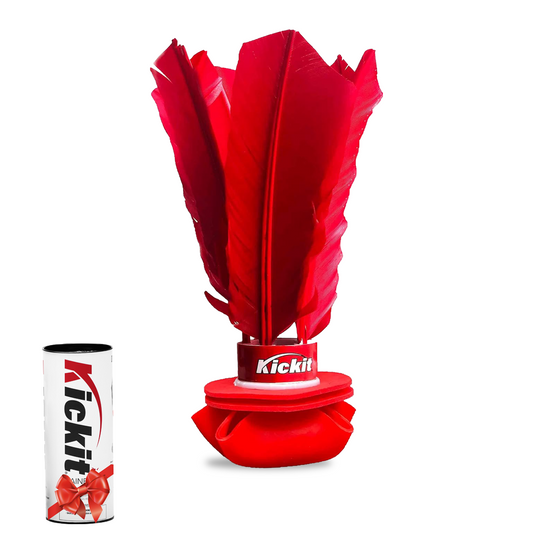
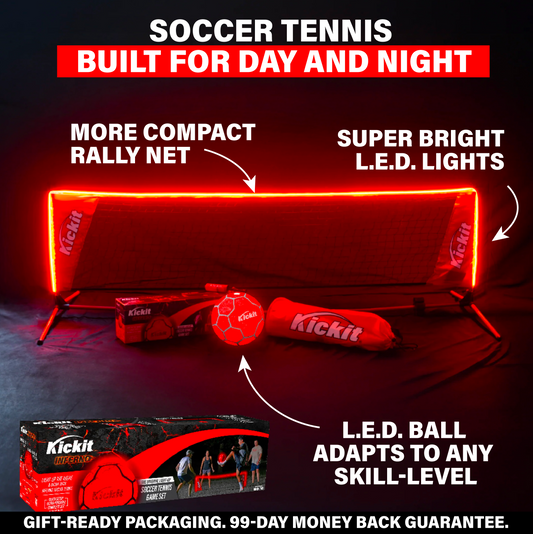
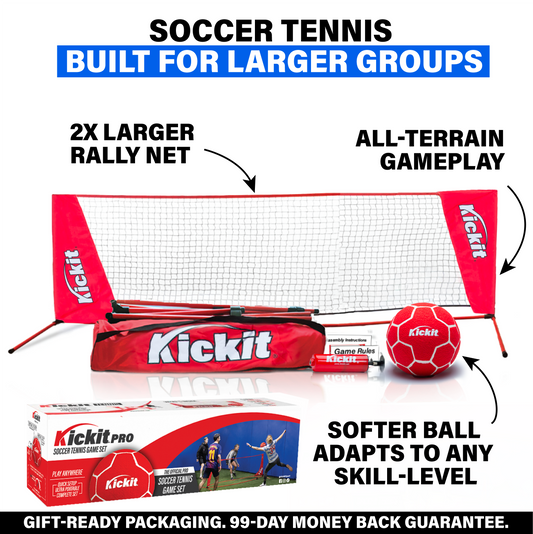
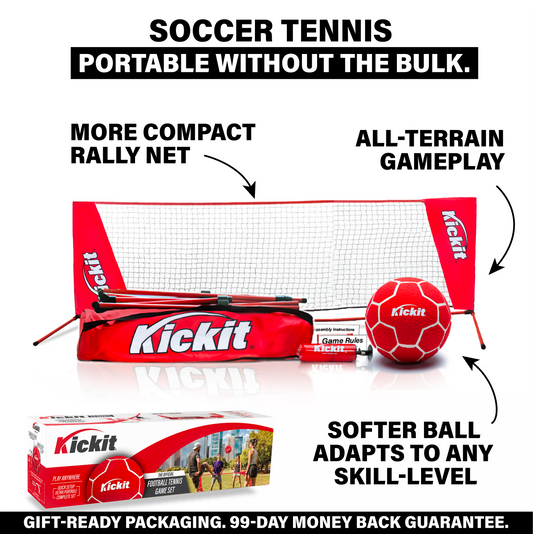
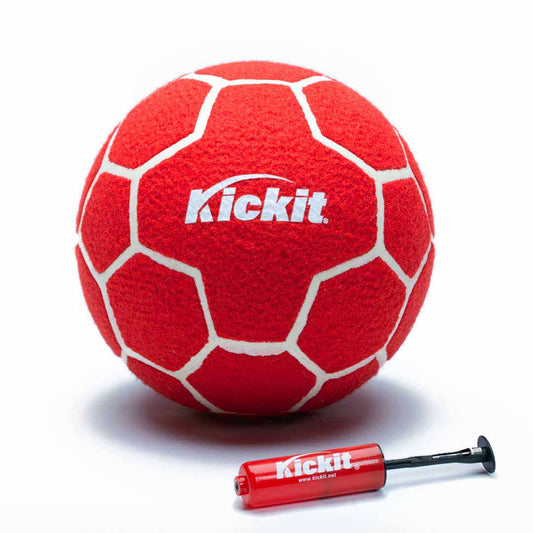
![[NEW] Inferno Kickit](http://kickit.net/cdn/shop/files/LED-Trainer_callouts.png?v=1761855747&width=533)

